
Good practices to ensure correct color matching.
1. Matching the color between printers
When having a fleet of different HP latex 3x00 / 1500 printers, one of the most common goals is to have the best color matching between printers. This enables the user to print large jobs with different printers or reprint any job in any available printer of the fleet.

* Color matching within a certain color accuracy threshold, for the same substrate and using equivalent print modes between printers. Other image quality attributes may be different between different products (i.e. grain, etc.).
2. How to manage a fleet of printers (same product).
Follow the next recommendations to learn how to manage your fleet for the best matching between all printers.
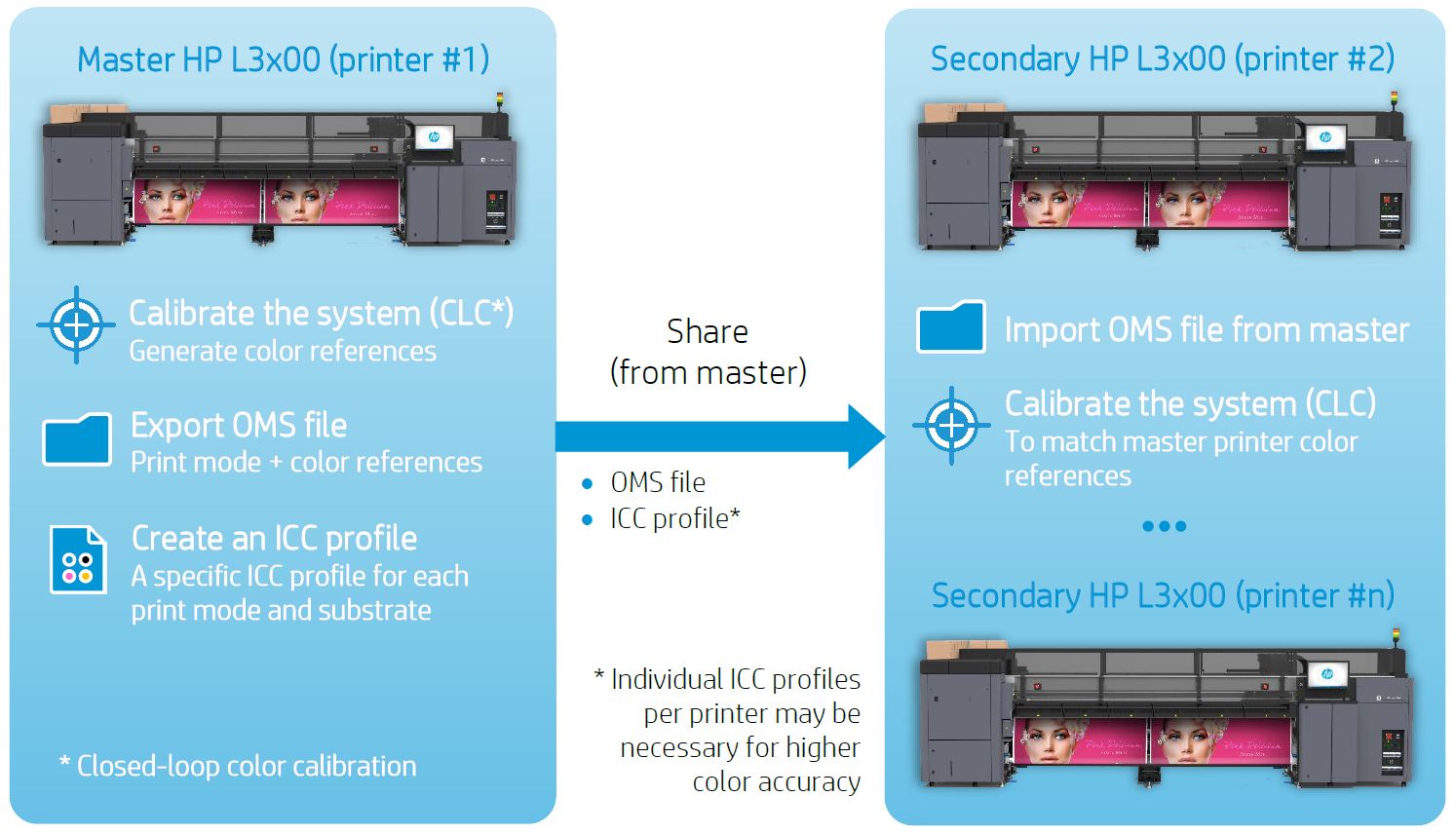
NOTE: Before starting the process, it is necessary to ensure that the printer is printing with good image quality. Check printhead nozzle health, printhead alignment, substrate advance, etc.
2.1 Prepare the master printer
For a given substrate:
2.1.1 STEP 1. Calibrate the color of the master printer (CLC)
When the Color Calibration functionality of the printer is used for the first time, the printer sets a color reference. In other words, the color calibration reference is like taking a picture of the printer status. Next, this color reference can be exported to the other printers of your fleet, and those can be calibrated using the same reference. This step is the most important, so it is the baseline for all your fleet management for the best color matching.
In the Internal Print Server, go to Substrate > Color Calibration and press Calibrate or Set color reference (depending on whether the reference has been set previously).
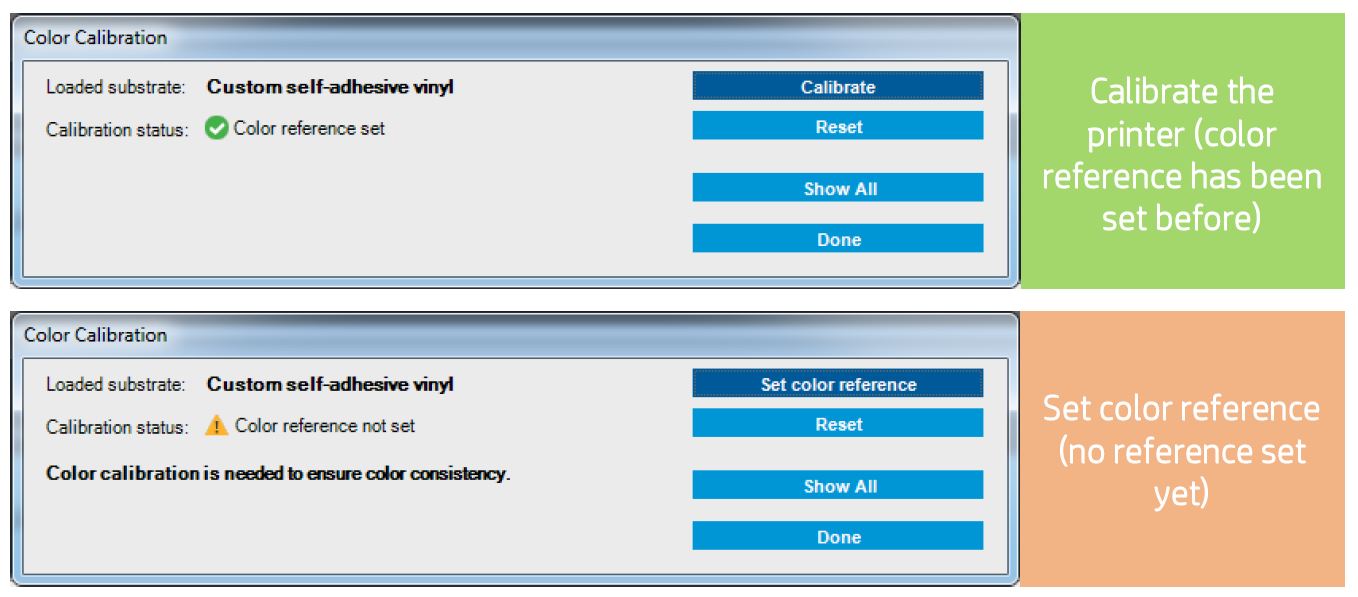
Once the reference has been set, the baseline for all your fleet management has been set.
2.1.2 STEP 2. Export OMS file from master printer
Once the color references have been set, select the print mode you want to use and adjust the settings to obtain good image quality (if necessary). Then, export the .oms file from the master printer, which contains color references and print mode information.
Go to Substrate > Preset Management
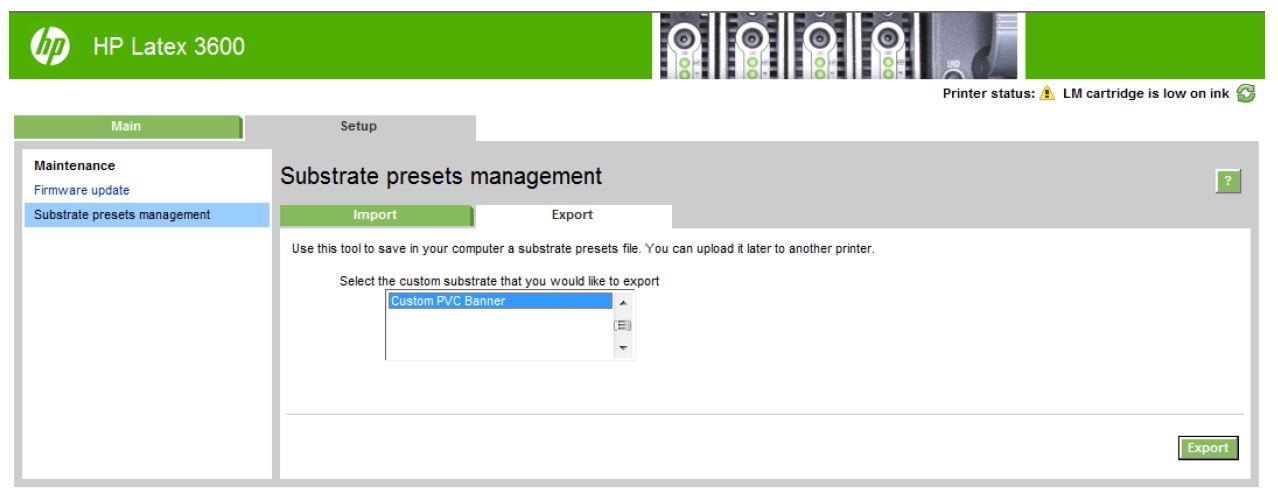
Next, go to the tab Export, select the substrate, and follow the instructions to export the file. This .oms file is the one that is going to be imported in the secondary printers.
2.1.3 STEP 3. Create an ICC profile for the master printer
Once the printer has been calibrated, select the print mode you want to use and create an ICC profile for that specific print mode. This ICC profile will be used to color manage the jobs for your fleet of printers.
2.2 Configure your secondary printer to match the master printer
2.2.1 STEP 1. Import OMS file from the master
Go to Substrate > Preset Management
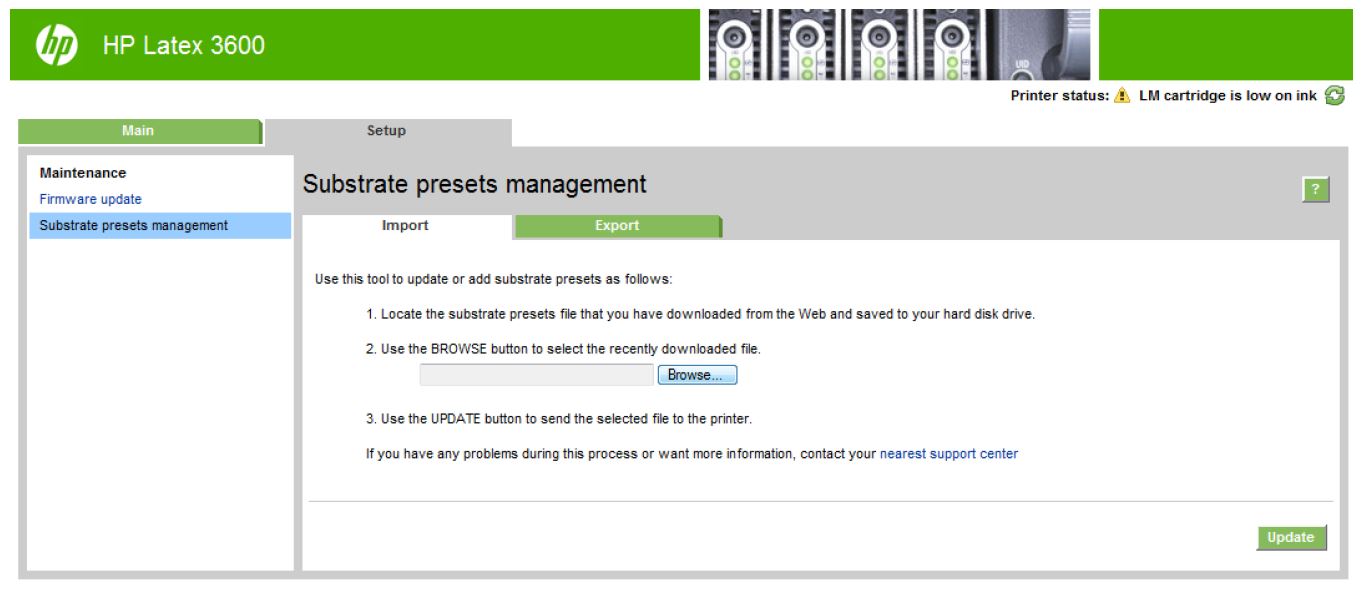
Then go to the tab Import, select the substrate, and follow the instructions to install the file into the printer.
2.2.2 STEP 2. Calibrate the system (CLC)
In this step, the color calibration uses the color references of the master printer for the best color matching between printers.
In the Internal Print Server, go to Substrate > Color Calibration and press Calibrate

Once the color calibration is done, the process is completed.
This process is substrate and print mode dependent:
• Each substrate will have its own CLC references, which will be valid for any print mode used with this substrate.
• Each print mode for the given substrate will have its own ICC profile.
This means that steps 1 and 2 of the master printer preparation are done just once per substrate, as well as steps 1 and 2 of the secondary printer configuration. Once that CLC references had been shared from the master printer (export .oms) to the secondary printer (import .oms), this is valid for all print modes, and there is no need to repeat this process. However, each print mode will need its own dedicated ICC profile.
2.3 Example
A user has a Custom PVC Banner and is using a 6p 6c 100% ink print mode. The process is as follows:
MASTER PRINTER:
• STEP 1: Calibrate the system → Create a CLC reference for the Custom PVC Banner substrate
• STEP 2: Export OMS file → Custom PVC Banner OMS file
• STEP 3: Create an ICC profile → For the 6p 6c 100% ink print mode using the Custom PVC Banner substrate
SECONDARY PRINTER:
• STEP 1: Import OMS file → Custom PVC Banner OMS file.
• STEP 2: Calibrate the system → Do a CLC using the Custom PVC Banner substrate.
After the completion of these steps, the ICC profile for the 6p 6c100% can be used for both printers.
Now, if a new 4p 6c 90% print mode needs to be used, only a new ICC profile will be necessary for that print mode and can be shared for both printers. It is not necessary to repeat steps 1 & 2.
NOTE: As mentioned before, a common ICC profile per print mode can be used for all printers. However, a high level of color accuracy may be required for some applications. In this case, it is recommended to create an individual ICC profile per printer and per print mode after completing step 2 in the secondary printer.
3. How to manage a fleet of printers (different products).
In this case, the fleet of printers combines Latex 3x00 and Latex 1500 printers. The process is identical to the previous scenario of a fleet of Latex 3x00 printers, but in this case, the ICC profile can’t be shared and it is mandatory to create individual ICC profiles per printer and print mode.
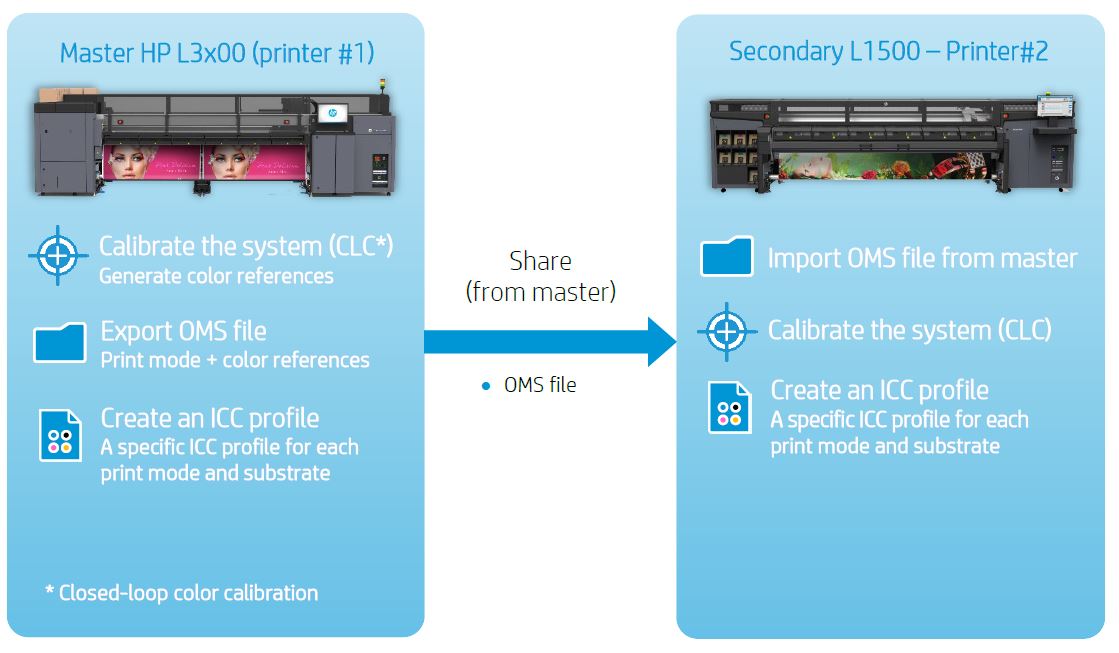
Remember that this process is substrate and print mode dependent, so OMS files will be shared for each substrate, but individual ICC profiles per printer and print mode must be created.
3.1 How to manage an HP Latex 500 in a fleet of HP Latex 3000/1500 printers
In some cases, an HP Latex 500 can be used in a fleet of printers for repeating samples, but the accuracy may not be enough for tiling or proofing. The HP Latex 500 printers are equipped with an internal library that makes them able to understand and translate the color from any other HP Latex generation 3 printer.
Check the cookbook “HP Latex 500 as a universal color emulator to every HP Latex generation 3 printers” to learn about the process to integrate an HP Latex 500 in your fleet of printers.
4. Tips for correct fleet management
Consider the following tips for the best color matching for your fleet of printers:
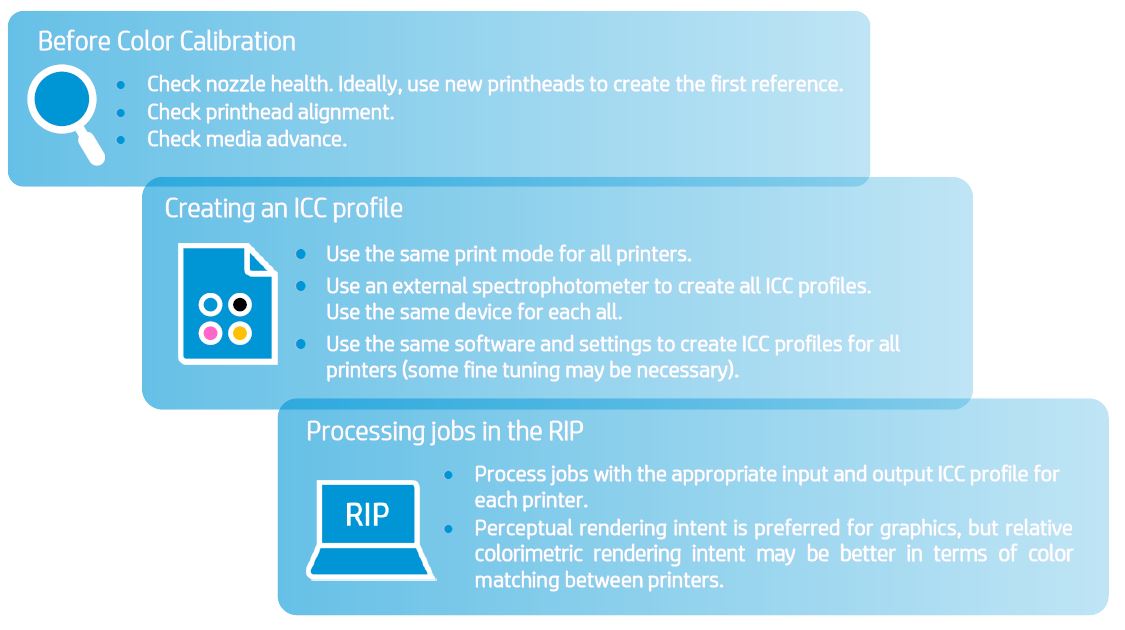
5. How to reprint with consistent colors
Reprints are one of the most common scenarios when printing: a print could get damaged during transportation or installation, customers might need more copies after some time…
Keeping consistency on reprints is possible following a color calibration process, a functionality embedded in the printer. Each printer has been calibrated in order to deliver an outcome that matches all other printers, so it is only needed to keep each printer calibrated to be consistent. This is an individual process per printer.
Check the cookbook “How to reprint with consistent colors on the same printer with the HP Latex 3x00 / 1500”, where you will find the fundamentals of the color calibration and detailed instructions about the procedure.
Although color calibration will ensure that reprints have a good level of color matching, ICC profiling after the color calibration may be necessary for very demanding color accuracy applications. Re-profiling will enhance the level of color accuracy and color matching between printers.










